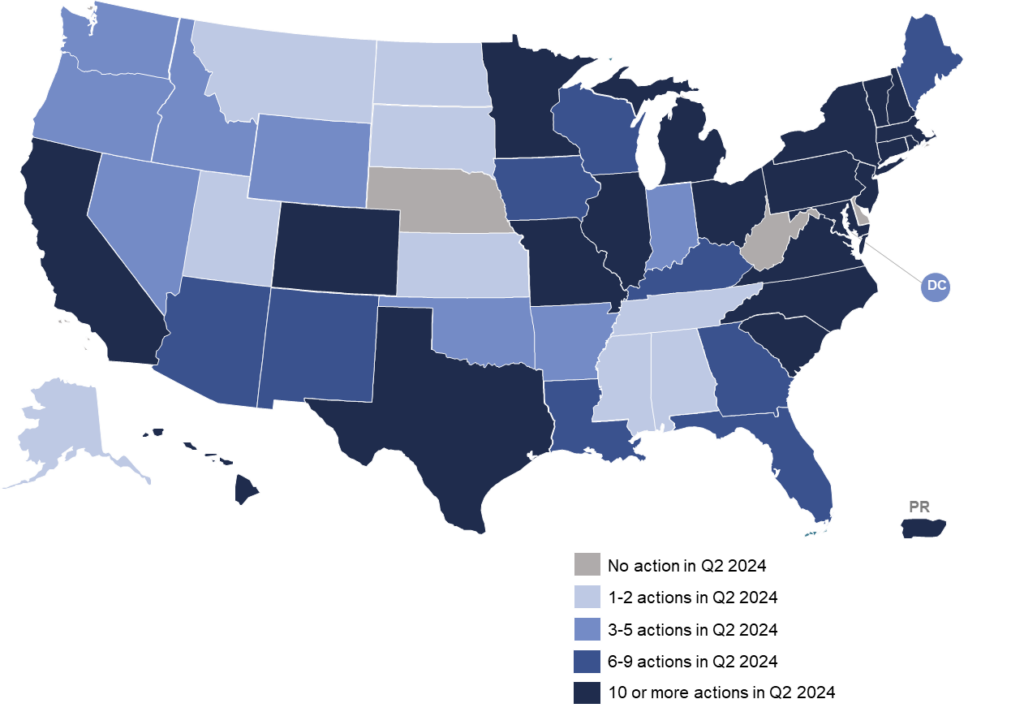The 50 States of Grid Modernization Q2 2024: States Investigate DER Aggregation in Wholesale Markets, While Utilities Plan for Grid Resilience in Q2 2024
Raleigh, NC – (July 30, 2024) The N.C. Clean Energy Technology Center (NCCETC) released its Q2 2024 edition of The 50 States of Grid Modernization. The quarterly series provides insights on state regulatory and legislative discussions and actions on grid modernization, utility business model and rate reforms, energy storage, microgrids, and demand response.
The report finds that 47 states, as well as the District of Columbia and Puerto Rico, took actions related to grid modernization during Q2 2024 (see figure below), with the greatest number of actions relating to energy storage deployment (55), overall utility business model reforms (50), distribution system planning (28), interconnection rules (28), performance-based regulation (28), and time-varying rates (26).
A total of 576 grid modernization actions were taken during Q2 2024. New York, Massachusetts, Michigan, California, New Jersey, and Minnesota took the greatest number of actions during the quarter, followed by Connecticut, Illinois, Hawaii, Missouri, Ohio, and New Hampshire.
Q2 2024 Legislative and Regulatory Action on Grid Modernization

The report discusses three trends in grid modernization actions taken in Q2 2024: (1) states addressing distributed energy resource aggregation in wholesale markets, (2) states investigating performance-based regulation, and (3) utilities undertaking grid resilience planning.
“In the second quarter of 2024, there were more than sixty utility plans including deployments of energy storage systems, microgrids, and/or demand response programs,” remarked Vincent Potter, Senior Policy Analyst at NCCETC. “Increasingly, utilities note the capacity for these types of projects to support, or potentially be part of, distributed energy resource aggregations and virtual power plants in addition to their historic capacity to provide load shedding, resiliency, and ancillary services.”
The report notes the top five policy developments of Q2 2024 were:
- Colorado lawmakers enacting virtual power plant and distribution system planning legislation;
- The New York Public Service Commission opening its Grid of the Future proceeding;
- Texas utilities filing transmission and distribution system resiliency plans;
- Rhode Island legislators adopting an energy storage target; and
- New Hampshire lawmakers passing microgrid study and grid planning legislation.
“State and utility activity related to distributed energy resource aggregation – also known as virtual power plants – has risen significantly this year,” observed Autumn Proudlove, Managing Director of Policy & Markets at NCCETC. “This quarter, we particularly saw regulators a number of states examining how distributed energy resource aggregators are able to participate in wholesale electricity markets and whether state regulatory changes are needed to facilitate this.”
View the 50 States of Grid Modernization Q2 2024 Quarterly Report Executive Summary
View and Purchase the 50 States of Grid Modernization Q2 2024 Quarterly Report
ABOUT THE N.C. CLEAN ENERGY TECHNOLOGY CENTER
The NC Clean Energy Technology Center, as part of the College of Engineering at North Carolina State University, advances a sustainable energy economy by educating, demonstrating and providing support for clean energy technologies, practices and policies. It serves as a resource for innovative, sustainable energy technologies through technology demonstration, technical assistance, outreach and training. For more information about the Center, visit: http://www.nccleantech.
Media Contact: Shannon Helm, NCCETC, shannon_helm@ncsu.edu